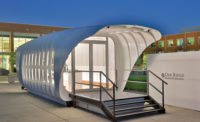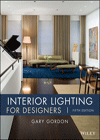Continuing Education: Lighting Controls

Photo © Warren Jagger
The ability to control electric light in a user-friendly and visually seamless manner became a viable design option for public, commercial, and residential spaces more than 50 years ago with Joel Spira’s invention of the solid-state electronic dimmer in the early 1960s. Initially developed to enhance homes and other interior environments, architectural lighting controls have since developed into systems that are used to create various scenes for retail and hospitality venues, provide security, and conserve energy usage and costs. Today, largely enabled by the capabilities of advanced, high-quality LEDs and digital technologies, lighting controls are being transformed into critical networks that not only effectively illuminate the spaces within and around buildings, they enhance the way these environments are used and inhabited.
In the half century that followed the introduction of a dimmer small enough to fit into a standard electrical wall box by Spira, the late founder of Lutron, the industry has evolved to keep up with myriad innovations and user preferences. Basic technologies such as 0–10 volt dimming—a protocol as straightforward as its name, developed first for stage lighting, then fluorescent lamps, and now LEDs—have been supplemented with more robust wired protocols such as DALI (Digital Addressable Lighting Interface) and DMX (Digital Multiplex), both encompassing products from different manufacturers that work together within each distinct convention. According to Arup lighting designer Jake Wayne, DALI is the workhorse that controls most of the typical white architectural lighting in buildings.
It’s a standard protocol whereby components such as LED drivers can be controlled individually, allowing for the fine-tuning of a particular fixture or small group of fixtures instead of a vast zone. DMX (a digital-communication network created for theatrical lighting) facilitates dynamic color-changing schemes. DMX is also great for new tunablewhite LEDs, which are growing in popularity. “So we might start to see more commingling of these two protocols in the architectural environment,” says Wayne.
“Typically on jobs, we end up with two or three control typologies just to address all of the requirements of a space,” Wayne explains. This scenario requires a central network system that has the built-in intelligence and programming capabilities to manage them. For example, Arup’s recently completed Boston office, where Wayne is based, is a “working lab” installed with several different control typologies. To manage them, the lighting design team is using a central system that controls all the protocols. “Think of it as a server that detects a group of DALI fixtures and knows how to talk to those through the DALI protocol, then recognizes the 0–10 volt fixtures and talks to those through the correct language,” he adds. But once it is implemented and commissioned, all that a facility manager sees is a clean floor-plan graphic through which one can view and modify the scheme. The actual process happens behind the scenes.
These open protocols, and the gateway solutions that integrate methodologies without a hitch, are essential for the adoption of new and existing products and technologies, says Joseph Bokelman, chairman of the Controls Protocols Committee for the Illuminating Engineering Society (IES). Many clients are risk-averse, so “the goal is to remove the complexity.” In this regard, connected wireless systems, which eliminate the need for extensive electrical work, are gaining ground with lighting designers and architects for retrofit installations and multitenant buildings, as well as for open office and retail applications where the lighting must adapt to variable spatial configurations.
Like the wired versions, open wireless protocols provide a common language to connect the devices of different manufacturers adopting a particular convention. One such standard, developed by Zigbee, has an alliance of 400 members, including manufacturers of luminaires, switches, and gateways, whose products communicate through low-frequency radio technology. Using a MESH network, the Zigbee system has self-healing properties, so if a route between any two devices is interrupted, it is reconfigured, making this a suitable technology for large and complex programs. “There is really no limit,” says Musa Unmehopa, a Philips Lighting senior director and Zigbee vice-chairman of the board. “You can build sub-networks and, in this modular fashion, grow or shrink a network to fit a particular building.” The Aria Las Vegas hotel is outfitted with 100,000 Zigbee nodes, Unmehopa says. Each guest room is its own network and connects to a central system. “This is how you gradually build up the infrastructure.”
At the same time that the lighting industry is moving toward increasingly integrated and interoperable systems, a new layer of luminaire connectivity is poised to have an effect on the built environment. As part of the growing phenomenon commonly referred to as the Internet of Things (IoT), manufacturers are beginning to embed light fixtures and even LED modules with smart sensors that measure conditions such as light levels, occupancy, temperature, and energy use. These communicate wirelessly and respond to distant and local commands, delivering data directly to facility managers as well as individuals at workstations, visitors to museums, even consumers at supermarkets and big-box stores.
These IoT capabilities present new possibilities for outdoor lighting systems at the urban scale. Manufacturers such as Philips and Current by GE offer connected lighting that goes well beyond turning streetlamps on or off. For instance, Philips is working with the city of Los Angeles and has outfitted its light poles with sensors that allow municipal managers to track energy use, determine if a particular lamp needs maintenance, and monitor grid health by detecting power fluctuations or surges. Some of the functionality has little to do with illumination: in September, the company completed a pilot installation of acoustic-sensing modules on 30 of LA’s streetlights. Susanne Seitinger, leader of Philips’s Global Smart Cities division, explains that the sensors process, map, and analyze peaks and averages rather than record sound. Some of the potential benefits are faster emergency response times after a car crash, or the ability to monitor noise pollution.
Many major LED manufacturers have already developed or are working on similarly “intelligent” lighting for building interiors, where a network of lighting fixtures can serve as the backbone for an indoor positioning system (IPS). Such networks, which pick up where global positioning systems (GPS) leave off, are being used in a number of different building types, including chain retailers like Walgreens, Toys“R”Us, and Target. IPS takes advantage of the ubiquity of lighting within stores, and can work in a number of ways. But often it communicates with shoppers’ smartphones via Bluetooth beacons integrated into the LED lamps or with visible light communication (VLC), which capitalizes on LEDs’ inherent flicker. These positioning technologies can help customers navigate the aisles and locate specific products and allow retailers to track inventory, notify customers of special promotions, and understand which areas of a store are most popular. The ultimate goal is, of course, to increase sales.
While sophisticated controls can certainly help an owner’s bottom line, architects and lighting professionals increasingly see such systems as a means of enhancing the quality of a space and the occupants’ experience of it. One example is the use of tunable-white LEDs. These lamps, which have color temperatures that range from warm to cool, can help regulate the body’s circadian rhythm (its internal clock), making people feel more alert during the day and sleep more soundly at night. The success of such lighting schemes depends on the amount and duration of exposure, color, and especially timing, points out Mariana Figueiro, the program director of the Lighting Research Center (LRC) at Rensselaer Polytechnic Institute in Troy, New York. “For the circadian system, the same light given at the wrong time will have negative effects, while at the right time it will be beneficial,” she explains. “That’s where advanced controls can play a major role.”
Figueiro sees the greatest potential for circadian applications in facilities that operate around the clock such as hospitals, nursing homes, and prisons. But these applications are also finding their way into the workplace. Even the General Services Administration (GSA), which owns and leases more than 376.9 million square feet in 9,600 buildings, could adopt circadian lighting. With the help of the LRC, the agency has been studying the effects of both daylight and electric illumination on circadian rhythms in a variety of its buildings. The investigations, which combined photometric measurements with occupant questionnaires, attempt to quantify the relationship between certain kinds of light and alertness, mood, and sleep quality. The project could shape the way the agency designs and renovates buildings. “The goal is to make evidence-based changes to our [construction] guidance documents,” says Bryan Steverson, a GSA high-performance- building program advisor.
If owners with holdings as extensive as the GSA’s were to embrace the capabilities of the latest lamp technologies and harness the potential of intelligent systems, the use of connected controls and their integration into the still nascent Internet of Things could soon become mainstream, say industry sources. “As long as we get the level of technology right, drive down the price, and get people to accept its security and reliability,” says Bokelman of IES, “we will create a platform that will carry us into the future—one that won’t be made irrelevant because it’s ‘just a light.’ ”
Read these case studies for more on lighting controls:
|
|
|
 |
Northeastern University Interdisciplinary Science and Engineering Complex |
 |
R/GA Office New York |
 |
Swedish Medical Center Behavioral Health Unit |
 |
Wimbledon Centre Court |
 |
Nelson-Atkins Museum of Art Bloch Galleries Renovation |
 |
Willem II Passage |
 |
Apartimentum |
|
Continuing Education
 To earn one AIA learning unit (LU), including one hour of health, safety, and welfare (HSW) credit, read the "Continuing Education: Lighten Controls" essay and the case studies above, review the supplemental material listed below, and complete the online test. Upon passing the test, you will receive a certificate of completion, and your credit will be automatically reported to the AIA. Additional information regarding credit-reporting and continuing-education requirements can be found online at continuingeducation.bnpmedia.com. To earn one AIA learning unit (LU), including one hour of health, safety, and welfare (HSW) credit, read the "Continuing Education: Lighten Controls" essay and the case studies above, review the supplemental material listed below, and complete the online test. Upon passing the test, you will receive a certificate of completion, and your credit will be automatically reported to the AIA. Additional information regarding credit-reporting and continuing-education requirements can be found online at continuingeducation.bnpmedia.com.Supplemental Material
"Designing with Circadian Stimulus," by Mariana G. Figueiro, Kassandra Gonzales and David Pedler Learning Objectives
AIA/CES Course #K1708A For CEU credit, read Command Performance and take the quiz at continuingeducation.bnpmedia.com, or use our Architectural Record Continuing Education app, available in the iTunes store. structure, finishes, and other original fabric when
a building is moved.
significant buildings.
|







